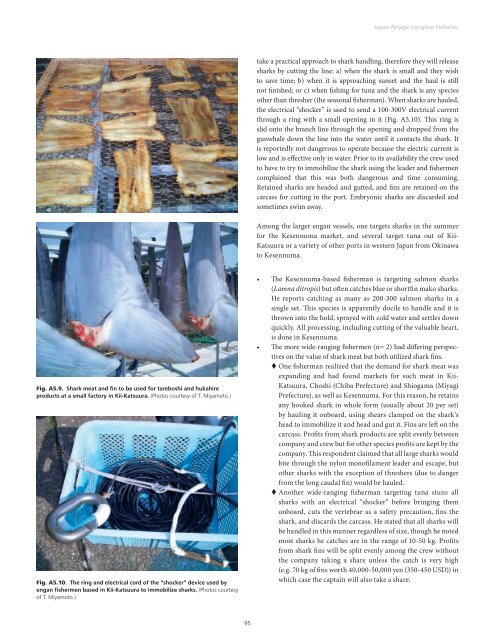Shark Depredation and Unwanted Bycatch in Pelagic Longline
Shark Depredation and Unwanted Bycatch in Pelagic Longline
Shark Depredation and Unwanted Bycatch in Pelagic Longline
Create successful ePaper yourself
Turn your PDF publications into a flip-book with our unique Google optimized e-Paper software.
Japan <strong>Pelagic</strong> Longl<strong>in</strong>e Fisheries<br />
take a practical approach to shark h<strong>and</strong>l<strong>in</strong>g, therefore they will release<br />
sharks by cutt<strong>in</strong>g the l<strong>in</strong>e: a) when the shark is small <strong>and</strong> they wish<br />
to save time; b) when it is approach<strong>in</strong>g sunset <strong>and</strong> the haul is still<br />
not f<strong>in</strong>ished; or c) when fish<strong>in</strong>g for tuna <strong>and</strong> the shark is any species<br />
other than thresher (the seasonal fisherman). When sharks are hauled,<br />
the electrical “shocker” is used to send a 100-300V electrical current<br />
through a r<strong>in</strong>g with a small open<strong>in</strong>g <strong>in</strong> it (Fig. A5.10). This r<strong>in</strong>g is<br />
slid onto the branch l<strong>in</strong>e through the open<strong>in</strong>g <strong>and</strong> dropped from the<br />
gunwhale down the l<strong>in</strong>e <strong>in</strong>to the water until it contacts the shark. It<br />
is reportedly not dangerous to operate because the electric current is<br />
low <strong>and</strong> is effective only <strong>in</strong> water. Prior to its availability the crew used<br />
to have to try to immobilize the shark us<strong>in</strong>g the leader <strong>and</strong> fishermen<br />
compla<strong>in</strong>ed that this was both dangerous <strong>and</strong> time consum<strong>in</strong>g.<br />
Reta<strong>in</strong>ed sharks are headed <strong>and</strong> gutted, <strong>and</strong> f<strong>in</strong>s are reta<strong>in</strong>ed on the<br />
carcass for cutt<strong>in</strong>g <strong>in</strong> the port. Embryonic sharks are discarded <strong>and</strong><br />
sometimes swim away.<br />
Among the larger engan vessels, one targets sharks <strong>in</strong> the summer<br />
for the Kesennuma market, <strong>and</strong> several target tuna out of Kii-<br />
Katsuura or a variety of other ports <strong>in</strong> western Japan from Ok<strong>in</strong>awa<br />
to Kesennuma.<br />
Fig. A5.9. <strong>Shark</strong> meat <strong>and</strong> f<strong>in</strong> to be used for tareboshi <strong>and</strong> hukahire<br />
products at a small factory <strong>in</strong> Kii-Katsuura. (Photos courtesy of T. Miyamoto.)<br />
Fig. A5.10. The r<strong>in</strong>g <strong>and</strong> electrical cord of the “shocker” device used by<br />
engan fishermen based <strong>in</strong> Kii-Katsuura to immobilize sharks. (Photos courtesy<br />
of T. Miyamoto.)<br />
• The Kesennuma-based fisherman is target<strong>in</strong>g salmon sharks<br />
(Lamna ditropis) but often catches blue or shortf<strong>in</strong> mako sharks.<br />
He reports catch<strong>in</strong>g as many as 200-300 salmon sharks <strong>in</strong> a<br />
s<strong>in</strong>gle set. This species is apparently docile to h<strong>and</strong>le <strong>and</strong> it is<br />
thrown <strong>in</strong>to the hold, sprayed with cold water <strong>and</strong> settles down<br />
quickly. All process<strong>in</strong>g, <strong>in</strong>clud<strong>in</strong>g cutt<strong>in</strong>g of the valuable heart,<br />
is done <strong>in</strong> Kesennuma.<br />
• The more wide-rang<strong>in</strong>g fishermen (n= 2) had differ<strong>in</strong>g perspectives<br />
on the value of shark meat but both utilized shark f<strong>in</strong>s.<br />
t One fisherman realized that the dem<strong>and</strong> for shark meat was<br />
exp<strong>and</strong><strong>in</strong>g <strong>and</strong> had found markets for such meat <strong>in</strong> Kii-<br />
Katsuura, Choshi (Chiba Prefecture) <strong>and</strong> Shiogama (Miyagi<br />
Prefecture), as well as Kesennuma. For this reason, he reta<strong>in</strong>s<br />
any hooked shark <strong>in</strong> whole form (usually about 20 per set)<br />
by haul<strong>in</strong>g it onboard, us<strong>in</strong>g shears clamped on the shark’s<br />
head to immobilize it <strong>and</strong> head <strong>and</strong> gut it. F<strong>in</strong>s are left on the<br />
carcass. Profits from shark products are split evenly between<br />
company <strong>and</strong> crew but for other species profits are kept by the<br />
company. This respondent claimed that all large sharks would<br />
bite through the nylon monofilament leader <strong>and</strong> escape, but<br />
other sharks with the exception of threshers (due to danger<br />
from the long caudal f<strong>in</strong>) would be hauled.<br />
t Another wide-rang<strong>in</strong>g fisherman target<strong>in</strong>g tuna stuns all<br />
sharks with an electrical “shocker” before br<strong>in</strong>g<strong>in</strong>g them<br />
onboard, cuts the vertebrae as a safety precaution, f<strong>in</strong>s the<br />
shark, <strong>and</strong> discards the carcass. He stated that all sharks will<br />
be h<strong>and</strong>led <strong>in</strong> this manner regardless of size, though he noted<br />
most sharks he catches are <strong>in</strong> the range of 10-50 kg. Profits<br />
from shark f<strong>in</strong>s will be split evenly among the crew without<br />
the company tak<strong>in</strong>g a share unless the catch is very high<br />
(e.g. 70 kg of f<strong>in</strong>s worth 40,000-50,000 yen (350-450 USD)) <strong>in</strong><br />
which case the capta<strong>in</strong> will also take a share.<br />
95












